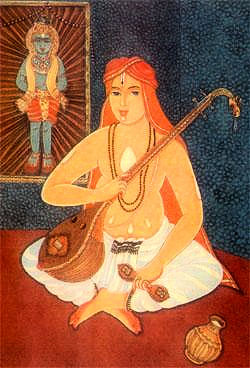

Kompiliert von Alois Payer
Zitierweise | cite as:
Payer, Alois <1944 - >: Musikalische Formen. -- 3. Konzertmusik. -- (Materialien zur karnatischen Musik ; 5.3). -- Fassung vom 2017-03-29. -- URL: http://www.payer.de/karnatischemusik/karnatisch053.htm
Erstmals veröffentlicht: 2009-05-05
Überarbeitungen: 2017-03-29 [Ergänzungen] ; 2009-05-22 [Ergänzungen] ; 2009-05-12 [Ergänzungen] ; 2009-05-08 [Ergänzungen]
©opyright: Creative Commons Licence (by, no commercial use)
Dieser Text ist Teil der Abteilung Sanskrit von Tüpfli's Global Village Library
| "At the present day, however, it is absolutely impossible for
anyone to gather an accurate knowledge of the principles of Hindu music without the aid of
learned natives, a practical acquaintance with the capabilities of their instruments,
and without consulting the best living performers—things that few persons have opportunity or leisure to attempt." Day, C. R. (Charles Russell) <1860-1900>: The music and musical instruments of southern India and the Deccan. -- London & New York : Novello, 1891. -- xvi, 173 S. : Ill. ; 25cm. -- S. 7 |
Bei allen Übertragungen von indischer Notation in westliche Notation habe ich willkürlich sa = c1 gesetzt. Da sa, ri usw. Tonstufen und keine festen Tonhöhen bezeichnen, sind die Transskriptionen je nach Stimmlage beliebig transponierbar.
Die elektronisch erstellten midi-Dateien sollen nur einen ersten Eindruck vom Melodieverlauf geben, sie können aber keinen rechten Eindruck von den Musikstücken geben. Dazu höre man Aufnahmen oder Konzerte von indischen Berufsmusikern.
Gute Aufnahmen karnatischer Musik findet man auf Spotify: https://www.spotify.com/de/. -- Zugriff am 2017-03-26
Eine gute Quelle, kostenlos karnatische Musik zu hören ist z.B. http://www.kannadaaudio.com. -- Zugriff am 2009-04-29
Die Taktangaben bei den Transkriptionen dienen NUR dem einfacheren Zählen, geben aber keine direkte Entsprechung zu den Tāla wieder (die ersten (Teil-)Schläge im Tāla sind durch Akzentzeichen gekennzeichnet).
Für die Notierungen gilt, was Bálint Sárosi zur Notierung von ungarischer Volksmusik sagt:
| "In einer Melodie, die wir mit zwei bis
drei verschiedenen Tönen notieren würden, kommt in Wirklichkeit ein
Vielfaches dessen vor." Sárosi, Bálint: Volksmusik : das ungarische Erbe. -- Budapest : Corvina, 1990. -- S. 31 |
Allgemein gilt:
| "Das Problem ist bekanntlich
allgemeiner Natur: Zwischen Notenbild und zu realisierendem
Klang klafft bei jeder Art von Musik eine Lücke, die durch eine
je spezifische, kulturell tradierte Aufführungs- und
Interpretationspraxis ausgefüllt wird. Das Umsetzungsproblem ist
dabei um so gravierender, je historisch älter oder
kulturgeographisch entfernter die jeweilige Musik ist." Bernhard-Friedrich Schulze ; Ehrenhard Skiera: Guitarra flamenca. -- In: Flamenco : gitano-andaluz / hrsg. von Claus Schreiner. -- Frankfurt am Main : Fischer-Taschenbuch-Verlag, 1985. -- (Fischer ; 2994). -- ISBN 3-596-22994-4. -- S. 143 |
Eine Grundunterscheidung karnatischer Musik ist:
Zu manodharma-saṃgīta = Improvisation bemerkt Kuckertz zurecht:
"Es handelt sich nicht um ein freies Phantasieren, auch nicht um die extemporierende Ausarbeitung eines gegebenen Themas. Vielmehr liegen der Improvisation im indischen Sinne stets bestimmte den Rāga charakterisierenden Kleinfiguren zugrunde. Diese fallen beim Vortrag oft recht verschieden aus. Aufgabe des improvisierenden Musikers ist, die Kleinfiguren nach mehr oder weniger festen, den einzelnen musikalischen Formen verpflichteten Regeln zu kombinieren und hierbei aufgrund der vorgegebenen Kleinfiguren auch neue Tonfiguren zu erfinden." Kuckertz, Josef <1930 - 1996>: Form und Melodiebildung der karnatischen Musik Südindiens : im Umkreis der vorderorientalischen und der nordindischen Kunstmusik / von Josef Kuckertz. - Wiesbaden : Harrassowitz, 1970. -- 2 Bde (Schriftenreihe des Südasien-Instituts der Universität Heidelberg). -- Bd. 1, S. 100.
Eine weitere Unterscheidung ist:
Hier werden Musikformen behandelt, die zum sabhāgāna gehören und nicht funktional-religiös sind (dazu siehe hier).
Zu Vokalmusik auf einen sinnvollen Text gehört
| "To
convey in writing an adequate idea of what an alāpa consists is
somewhat difficult ; it is not exactly a song, the music not being
set to any particular words ; neither is it an air, for it is not
confined in its rhythm. An alāpa may be said to be rather a kind of
rhapsody, which abounds with grace and embellishments of all kinds,
and is formed by an extension, according to the mūrchanā, of the
notes of the rāga, in such a way that all the characteristics of
that rāga are prominently shown, and scope is given to the
performer's power of improvising. The phrases vary in length, some being slow, with quick modulations succeeding, and others vice versa, the beats upon the accompanying strings marking the time being given at the performer's fancy. As a rule the voice is not employed in the performance of an alāpa ; but if used at all it is either in unison with the instrument or else accompanied by a simple running accompaniment upon the open strings. Occasionally the voice is relieved by the instruments taking up the melody, varied with soft imitations in the same rāga. In fact, so much is left to the taste and fancy of the musician, that it is impossible to lay down any definite rules for the constitution of an alāpa ; hence, as may be imagined, in movements of this sort, there is a kind of wild charm which seems to carry with it a plaintive refrain that lingers on in the mind of the listener long after the music has ceased. Perhaps the only composer who appears to have caught the entire spirit of these peculiar improvisations is Chopin ; though, as far as we know, his acquaintance with Oriental music must have been limited." Day, C. R. (Charles Russell) <1860-1900>: The music and musical instruments of southern India and the Deccan. -- London & New York : Novello, 1891. -- xvi, 173 S. : Ill. ; 25cm. -- S. 41f. |
Ālāpana (Ālāpa, ālapati) = Exposition eines Rāga ohne Tāla (Metrum).
Siehe auf Spotify unter dem Stichwort "Aalapana"
Beispiele auf Spotify:
gespielt von Mambalam M.K.S. Siva
URI: spotify:track:3Oh4BTEamfHyVawZR9LFnP
URL: https://open.spotify.com/track/3Oh4BTEamfHyVawZR9LFnPgespielt von N. Ravakiran:
URI: spotify:track:63v10nDyNjwic9WZFkFILx
URL: https://open.spotify.com/track/63v10nDyNjwic9WZFkFILxgespielt von T.R. Mahalingam u.a.:
URI: spotify:track:4Zz4Gbt5WwK25hc7Mc19YQ
URL: https://open.spotify.com/track/4Zz4Gbt5WwK25hc7Mc19YQ
Man unterscheidet:
Im Ālāpana eines Rāga sollten nur die Silben ta, da, ri, na, tom verwendet werden. Manchmal werden auch heilige Namen wie Śaṅkara oder Rāma verwendet.
Ein Ālāpana besteht aus folgenden Teilen, die nach Sambamoorthy (Bd. Iv., S. 20) idealiter folgende Dauer haben sollten:
Ākṣiptikā: 5 min.
Rāgavardhanī: 32 min.
Sthāyī: 8 min.
Madhyamakāla / Tāna: 15 min.
Einzelheiten dazu siehe in
Sambamoorthy, P. <1901 - 1973>: South Indian music. -- Book IV. -- Reprint of the 8th ed., 1998 -- Chennai : Indian Music Publishing House, 2007. -- S. 6 - 20.
Kṛti / Kriti ist die häufigste Form karnatischer Konzertmusik. Eine typische Kṛti besteht mindestens aus drei Teilen (aṅga) ("Sätzen"): Pallavi - Anupallavi - Caraṇa
"Die Kṛti-Form besteht aus drei
Aṅga (Gliedern), dem Pallavi, dem Anupallavi und dem Caraṇa.
Manche Kṛti hat mehrere Caraṇa, und oft erscheint am Schluss des (oder der) Caraṇa noch einmal der abgekürzte Pallavi oder Anupallavi. Diesen konstituierenden Gliedern werden einige dekorative Glieder eingefügt, ohne das Formschema Pallavi — Anupallavi — Carana zu verändern." Kuckertz, Josef <1930 - 1996>: Form und Melodiebildung der karnatischen Musik Südindiens : im Umkreis der vorderorientalischen und der nordindischen Kunstmusik / von Josef Kuckertz. - Wiesbaden : Harrassowitz, 1970. -- 2 Bde (Schriftenreihe des Südasien-Instituts der Universität Heidelberg). -- Bd. 1, S. 126. |
| "The
various styles of Indian compositions, consisting as they do
entirely of melody, do not present to the casual observer
differences as clearly marked as in those of European music.
Nevertheless these melodies are classified systematically, and in
their construction are subject to certain definite rules of
composition. Almost all consist of a burden or refrain called
Pallevi, a kind of answer to this refrain styled Anupallevi, and
stanzas (called Charanam) of which there is usually an uneven
number. These parts are in the several compositions arranged in
different ways, and by this means the style of composition is
determined." Day, C. R. (Charles Russell) <1860-1900>: The music and musical instruments of southern India and the Deccan. -- London & New York : Novello, 1891. -- xvi, 173 S. : Ill. ; 25cm. -- S. 60. |
Wenn die Caraṇa's je eine eigene Melodie haben, müssen alle gesungen werden. Sind Caraṇa's aber Strophen zu einer einzigen Melodie, kann der Sänger entscheiden, wie viele er singen will. Normalerweise wird das Caraṇa gesungen, in dem die Mudrā, der offene oder verschlüsselte Namen des Komponisten enthalten ist.
Einige kṛti von Muttusvāmi Dīkṣitar (முத்துஸ்வாமி தீக்ஷிதர்;ముత్తుస్వామి దీక్షితార్) (1775 – 1835) haben nur zwei Sätze:
Pallavi - Samaṣṭicaraṇa
Zu den Drei Sätzen können noch weitere Sätze als Verzierungen hinzukommen, nämlich:
Ciṭṭasvara
Svarasāhitya
Madhyamakālasāhitya
Solkaṭṭusvara
Saṃgati
Vorbild für viele Kṛti sind die Kṛti von Tyāgarāja (త్యాగరాజ ; தியாகராஜா) (1767 - 1847)
Künstlerlink auf Spotify:
URI: spotify:artist:4bL34J5iZitrBLMZ9LZJTu
URL: https://open.spotify.com/artist/4bL34J5iZitrBLMZ9LZJTu
Gegenwärtig sind über 10.000 Kṛti in Gebrauch. Die meisten Texte (sāhitya) sind in Telugu, gefolgt von Sanskrit, Tamil und Kannada. Es gibt auch Kṛtis mit Texten in Malayalam, Hindi und mehrsprachige. Die überwiegende Mehheit ist in ādi-tāla. Kṛtis in über 400 Rāga existieren.
Einige Beispiele für Kṛti auf Spotify:
Album: Gurukula: 50 madhyamakala kritis / Mysore Nagamani Srinath:
URI: spotify:album:6HFHBMqobf8P7DWqjfxXRQ
URL: https://open.spotify.com/album/6HFHBMqobf8P7DWqjfxXRQvon Madurai Shanmukhavadivu Subbulakshmi:
URI: spotify:track:2qOtYCP9WqehjTqnFv9y5G
URL: https://open.spotify.com/track/2qOtYCP9WqehjTqnFv9y5Gvon Semmangudi Srinivasa Iyer u.a.:
URI: spotify:track:1ZItm01rvfTa8o7QoRMZc3
URL: https://open.spotify.com/track/1ZItm01rvfTa8o7QoRMZc3von Seeta Doraiswamy:
URI: spotify:track:3tsH5C65akGTHBpj5hdoFb
URL: https://open.spotify.com/track/3tsH5C65akGTHBpj5hdoFbvon Alathur Srinivasa Iyer u.a.:
URI: spotify:track:4MkmVAERuRFd9slFGVH340
URL: https://open.spotify.com/track/4MkmVAERuRFd9slFGVH340von A.K.C. Natarajan u.a.
URI: spotify:track:0N8zgsVVyPxjG2pmQtwG9d
URL: https://open.spotify.com/track/0N8zgsVVyPxjG2pmQtwG9dvon Seeta Doraiswamy:
URI: spotify:track:4Ntx1COjcNBXHTFWEed56f
URL: https://open.spotify.com/track/4Ntx1COjcNBXHTFWEed56fvon Lakshminarayana Subramaniam u.a.:
URI: spotify:track:06LnHK8iPWhIQViVgMeLfX
URL: https://open.spotify.com/track/06LnHK8iPWhIQViVgMeLfX
Beispiele zu Pallavi, Anupallavi und Caraṇa usw. siehe bei Abhyāsagāna = Übungsstücke, Religiös-funktionale Musik und Tanz und Tanzmusik.
Beispiel: entani nē
Tāla: rūpaka O |4 (2 + 4)
Rāga: Mukhāri: janya zu Meḷa 22: Kharaharapriya
Dichterkomponist: Tyāgarāja (త్యాగరాజ, தியாகராஜா) (1767 - 1847)
Vorlage: Umschrift von Josef Kuckertz in: Musik in Asien. - 1. Indien und der Vordere Orient / Josef Kuckertz <1930 - 1996>. -- Beispielheft. -- Kassel : Bärenreiter, 1981. -- ISBN 3-7618-0653-1. -- S. 25.
Der Song, gesungen von M. Balamuralikrishna auf Spotify:
URI: spotify:track:61Vi8e7oDW31e6hlntQJFg
URL: https://open.spotify.com/track/61Vi8e7oDW31e6hlntQJFg
Text (sāhitya) Pallavi:
ఏన్తని నే వర్ణిన్తును శబరీ భాగ్య
entani nē varṇiṃtunu śabarībhāgya
Pallavi
How can I (entani nē) describe (varṇiṃtunu) the great good fortune (bhāgya) of ŚabarīAnupallavi: దాన్తుల వర కాన్తులు జగమన్త నిణ్డియుణ్డగ
dāntula varakāntalu jagamanta niṇḍiyuṇḍaga
Anupallavi [The Lord sought her of His own accord, and gave her Darshana, i.e. His vision. This is an honor which] no one among the thousands of spouses (kāntalu) of ascetics (dāntula) in the same world (jagamanta) could aspire for (niṇḍiyuṇḍaga)!
Caraṇa: కనులార సేవిఞ్చి కమ్మని ఫలముల నోసగి తనువు పులకరిఞ్చ పాదయుగములకు మ్రోక్కి ఇనకులపతి సముఖమ్బున పునరావృత్తిరహిత పదమును పోన్దిన త్యాగరాజనుతురాలి పుణ్యమ్బున
kanulāra sēviñci kammani phalamula nosagi tanuvu pulakariñca pādayugamulaku mrokki ina-kulapati samukhambuna punarāvṛittirahita padamunu pondina tyāgarājanuturāli puṇyambuna
Caraṇa: Śabarī worshipped (sēviñci) him in front of her eyes (kanulāra). She offered (nosagi) Him, the gem of the solar race, the choicest (kammani) of fruits (phalamula) she had gathered with great care and affection. In supreme ecstasy (pulakariñca) she prostrated (tanuvu) before Him (ina-kulapati) (pādayugamulaku) obtaining release (rahita) from worldly (samukhambuna) bondage (punarāvṛtti) and attained Beatitude (padamunu pondina).
Paraphrase: T.K. Govinda Rao, zitiert: http://www.ecse.rpi.edu/Homepages/shivkuma/
personal/music/entanine.htm. -- Zugriff am 2009-05-07
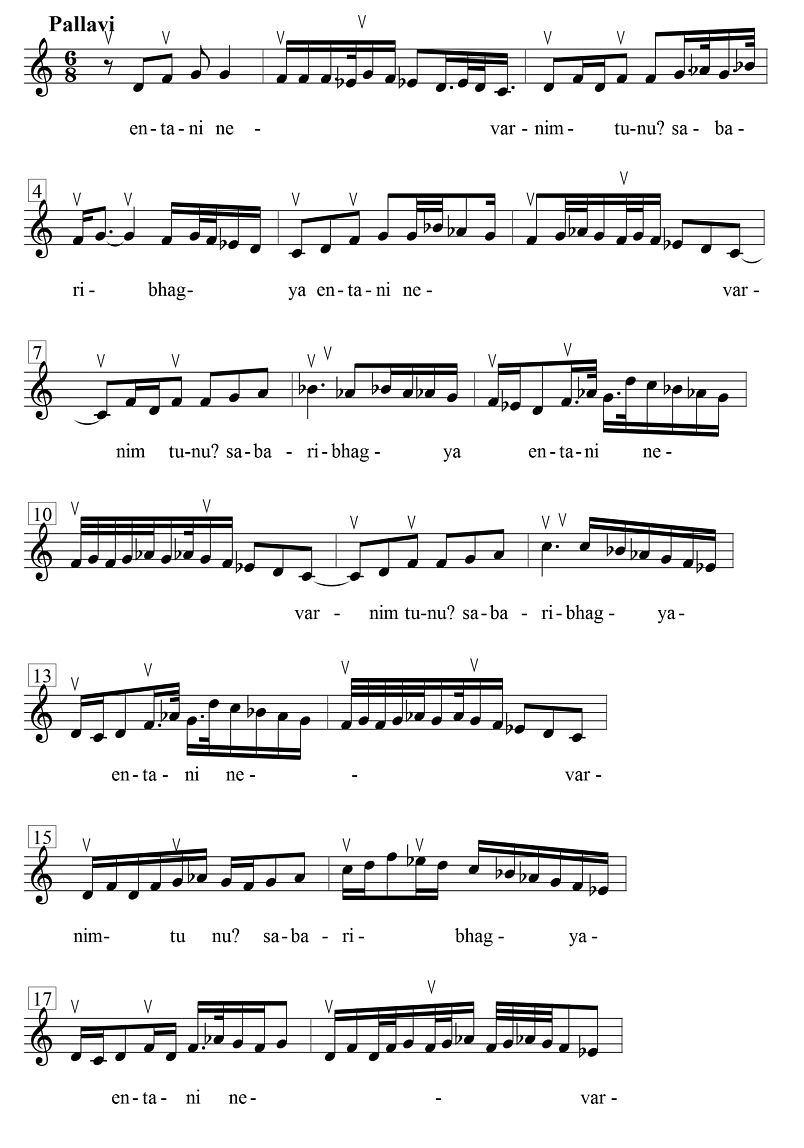
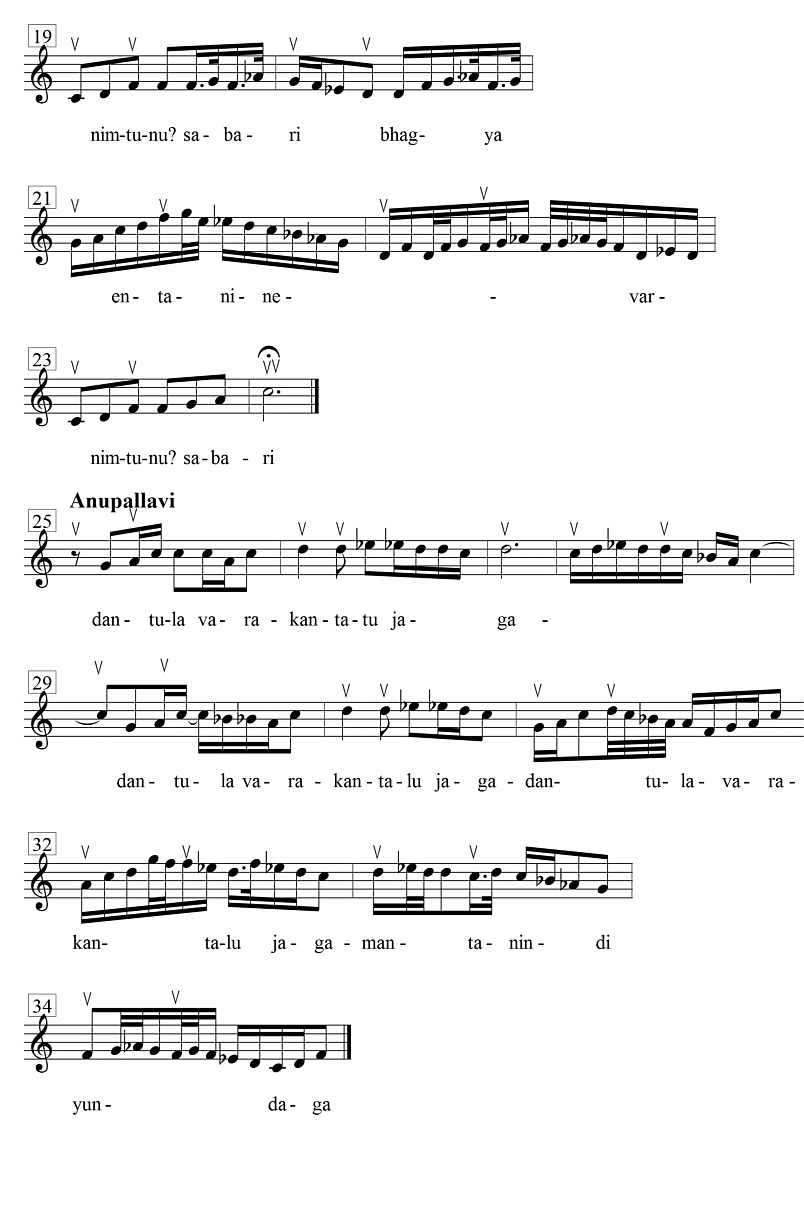
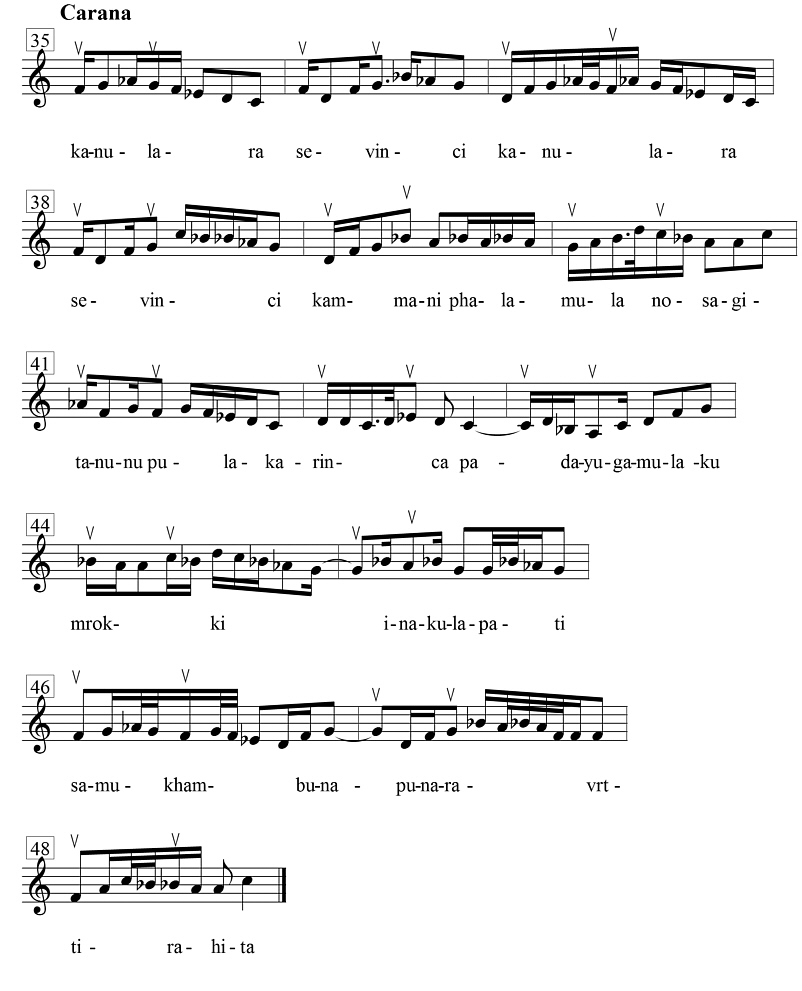
Abb.: entani nē
| "Pallevi, a kind of fantasia upon
some theme abounding in imitation, and with a well-defined rhythm." Day, C. R. (Charles Russell) <1860-1900>: The music and musical instruments of southern India and the Deccan. -- London & New York : Novello, 1891. -- xvi, 173 S. : Ill. ; 25cm. -- S. 61. |
P. Sambamoorthy schreibt als einleitende Worte zu Pallavi:
| "Now we come to
the Pallavi, the most important branch of creative music. Pallavi
may be styled the Chrest jewel of manodharma saṅgīta. The
performer's creative talents, his mastery of rhythm and grasp of
technical details are all put to the utmost test here. It is in this
branch of manodharma saṅgīta that the musician has ample
opportunities of displaying his creative talents, imaginative skill
artistic sense and musical intelligence. There have been instances
of musicians who, not possessing the gifts for making good rāga
ālāpanas have shone as eminent singers of pallavis. Similarly there
have been instances of musicians who had a genius for rāga ālāpana
but who were very poor at pallavi. The pallavi proper, including the
saṅgātis, belongs to the sphere of kalpita saṅgīta, since the whole
thing is well thought out beforehand and composed either by the
performer himself or by some other musician. But the exposition of
the pallavi, which is the most important part of it belongs to the
sphere of manodharma saṅgīta. The presence of musical and literary
beauties in some pallavis adds a charm to the theme. To listen to a
good pallavi exposition is a rare privilege and a treat to the ear. [...] Though the art of Pallavi-exposition is hinted at in a vague manner in the Saṃgīta-ratnākara of Sārṇgadeva (early 13th cent.), yet it did not attain its full development until the eighteenth century. This art is unquestionably the brightest product of the South Indian musical genius. The Pallavi is the largest item in a South Indian concert and contributes greatly to its academic and aesthetic value. Rāga ālāpana is un-measured music, while pallavi is measured music. The pallavi constitutes the necessary counterpart of the long drawn-out ālāpana of a major rāga. The detailed ālāpana and the pallavi rightly occupy the central place in the South Indian concert programme. Pallavi is in a sense, rāga ālāpana in measured form, woven round a stock theme. Eminent musicians and composers in the past have distinguished themselves as great performers of pallavi. Many pallavi contests have taken place in the samasthānas of Rājas and Zamīndārs. Posterity remembers with pride and zeal the historic events that brought forth some of the excellent pallavis that we possess now." Sambamoorthy, P. <1901 - 1973>: South Indian music. -- Book IV. -- Reprint of the 8th ed., 1998 -- Chennai : Indian Music Publishing House, 2007. -- S. 20f. |
Das Wort Pallavi ist angeblich (!) gebildet aus den Anfangssilben der drei Worte
pada = Wort
laya = Metrum und Tempo
vinyāsa = Variation
Der Text eines Pallavi kann religiös oder profan sein. Er kann in jeder Sprache sein. Er kann in jedem Rāga, Tāla und Tempo sein.
Ein Pallavi besteht aus zwei Teilen; der Teilungspunkt heißt पदगर्भ = padagarbha oder அறுதி = aruti (arudi). Die beiden Teile heißen
प्रथमाङ्ग = prathamāṅga = erster Teil
द्वितीयाङ्ग = dvitīyāṅga = zweiter Teil
Beispiele für Pallavi auf Spotify:
URI: spotify:track:06AkogzYY1X30DCyiZaBsC
URL: https://open.spotify.com/track/06AkogzYY1X30DCyiZaBsCURI: spotify:track:2fe8Ul2U1B0gUKQBSWp034
URL: https://open.spotify.com/track/2fe8Ul2U1B0gUKQBSWp034
Beispiel eines kurzen Pallavi:
Tāla: Rūpaka O |4 (2 + 4)
Rāga: Hindusthāni kapi: janya-auḍava-saṃpūrṇa-upāṅga-vakra zu Meḷa 22: Kharaharapriya
Abb.: Tonmaterial von Kharaharapriya

Abb.: Tonleiter von Hindusthāni Kapi
Komponist: ?
Vorlage: Sambamoorthy, Bd. IV., S. 24
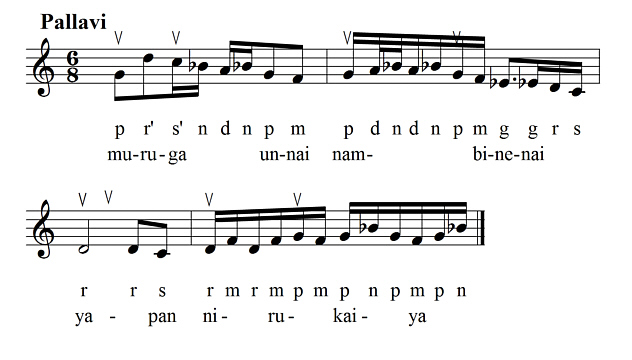
Abb.: Pallavi
Die Entwicklung eines Pallavi kann in folgenden Stufen geschehen:
Der Pallavi wird drei- oder viermal gesungen; Teile des Pallavi werden variiert (saṃgati): 5 Minuten
Der Pallavi wird entweder bei gleichem Tāla in doppeltem oder vierfachem Tempo gesungen (anuloma) oder der Pallavi wird in gleichem Tempo gesungen, während der Tāla in doppeltem oder vierfachem Tempo gezählt wird (pratiloma): 5 min.
Tisra: Unterteilung eines Schlags des Tāla in drei Teile pro Schlag: 3 min
Niraval: in Teile des Pallavi werden neue Melodieteile eingefügt
Kalpanasvara: Teile des Texts des Pallavi werden durch sinnlose Silben ersetzt: 15 min
Rāgamālikā, Tālamālikā oder Rāgatālamālikā (siehe unten): 20 min
Singen des ursprünglichen Pallavi in einem etwas schnelleren Tempo: 5 min
Nach den Vorstellungen von Sambamoorthy ergäbe sich so eine Gesamtdauer des Pallavi von einer Stunde.
Ciṭṭasvara ist ein kurzes, vorkomponiertes Zwischenstück ohne sinnvollen Text. Er besteht aus 2 oder 4 āvarta (tāla-Perioden), wenn er in ādi-tāla ist, aus 8 oder 16 āvarta, wenn er in cāpu, tripuṭa oder rūpaka Tāla ist.
Ein Kunststück unter ciṭṭa-svara ist viloma-ciṭṭa-svara, eine ciṭṭa-svara, den man unter Beibehalt des Rāga von vorne nach hinten (anuloma) und von hinten nach vorne (pratiloma) gesungen werden.
Ciṭṭa-svara, von Gajendhran erklärt, auf Spotify:
URI: spotify:track:5TVtGWvrEbLofjasqut7od
URL: https://open.spotify.com/track/5TVtGWvrEbLofjasqut7od
Ein klassisches Beispiel ist
Beispiel: Ciṭṭa-svara zu Kamalāmbām bhajare
Tāla: ādi |4 O O (4 + 2 + 2)
Rāga Mecakalyāṇī
Abb.: Tonmaterial von MecakalyāṇīKomponist: Muttusvāmi Dīkṣitar (முத்துஸ்வாமி தீக்ஷிதர்; ముత్తుస్వామి దీక్షితార్) (1775 – 1835)
Vorlage: Sambamoorthy, Bd. III, S. 143
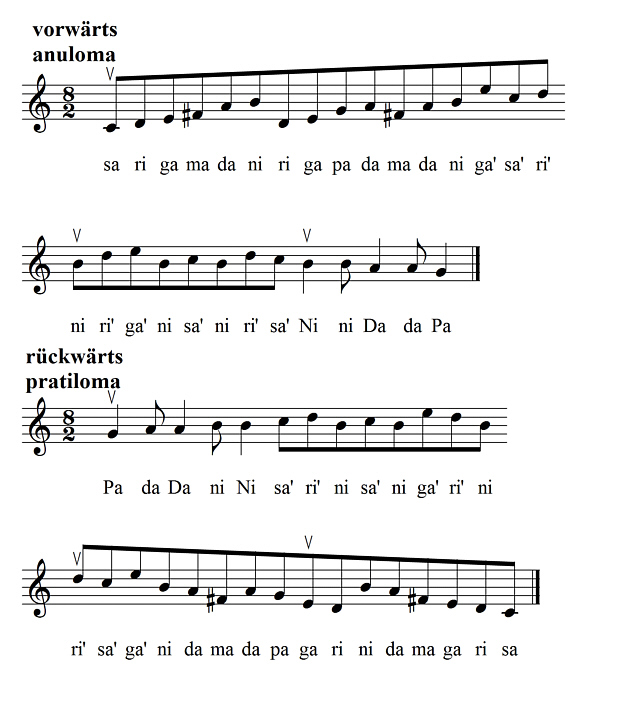
Abb.: viloma-ciṭṭa-svara
Svarasāhitya ist eine Verbindung von Ciṭṭasvara mit sinnvollem Text (sāhitya)
Madhyamakālasāhitya ist integrierender Bestandteil einer Kṛti. Es steht am Ende des Anaupallavi und oder Caraṇa. Es ist im zweiten Tempo (madhyamakāla).
Solkaṭṭusvara ist ein Ciṭṭasvara, bei dem statt der sa-ri-ga-ma Silben die rhythmischen Silben (Jati/Solkaṭṭu) ta-ka-dhi-mi etc. gesungen werden. Solkaṭṭusvara dürfen nur in Kompositionen vorkommen, die sich auf einen Gott beziehen, der mit Tanz zu tun hat, also Śiva Nāṭarāja, Kṛṣṇa oder Gaṇeśa. Es gibt auch Verbindungen von Solkaṭṭu und Sāhitya (sinnvoller Text), nämlich Solkaṭṭusvarasāhitya und Solkaṭṭusāhitya.
Erklärungen zu Solkaṭṭu von Gajendhran auf Spotify:
URI:
spotify:track:6VwxNVfbUIw7Oi0nDZQJw2
URL:
https://open.spotify.com/track/6VwxNVfbUIw7Oi0nDZQJw2
URI:
spotify:track:4lTfKrC7odHtFtvPCgNbYI
URL:
https://open.spotify.com/track/4lTfKrC7odHtFtvPCgNbYI
URI:
spotify:track:6rmqazgkHzjEUa74Hp5xCS
URL:
https://open.spotify.com/track/6rmqazgkHzjEUa74Hp5xCS
Saṃgati (Saṅgati) ist eine stufenweise entwickelte Variation über ein musikalisches Thema. Jede Saṃgati entwickelt die vorhergehende weiter. Saṃgatis können vom Ende des Themas des Pallavi her entwickelt werden, vom Anfang her oder von der Mitte her. Sambamoorthy stellt das graphisch so dar:
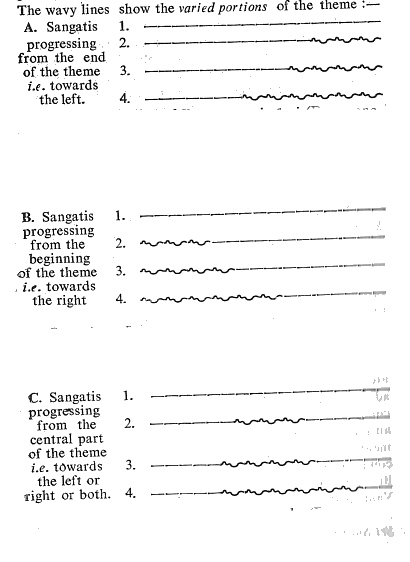
Abb.: Verschiedene Saṃgati
[Bildquelle: Sambamoorthy, P. <1901 - 1973>: South Indian music. -- Book III. -- Reprint. -- Chennai : Indian Music Publishing House, 2008. -- S. 152f. -- Fair use]
In der Regel wird jede Saṃgati zweimal gesungen.
Improvisierende Variationen über ein Thema oder Teilthema (oft aus dem Anupallavi), konzentriert auf den Text (sāhitya) des Themas.
Beispiele für Niraval, erklärt von T.R. Subramanyam, auf Spotify:
Beispiele: Bhagyalekshmy, S., Part 4, S. 47 - 60
Rāgamālikā sind Kompositionen, die aus einer Reihe musikalischer Formen (z.B. Jatisvara, Svarajati, Śabda, Tānavarṇa, Padavarṇa, Tillānā etc.) bestehen, wobei jedes Glied, manchmal jede Zeile eines Verses in einem anderen Rāga komponiert ist. Tanz-Rāgamālikā geben der Tänzerin / dem Tänzer Gelegenheit zu Ausdruck (abhinaya).
Wichtige Dichterkomponisten (vāggeyakāra) sind u.a.:
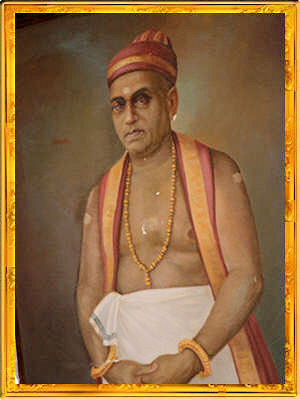
Abb.: Irayimman Tampi
[Bildquelle: Wikipedia. Public domain]
Tālamālikā sind Kompositionen, in denen jedes Glied (aṅga, Satz) einen anderen Tāla (Metrum) hat. Ein berühmter Komponist von Tālamālikā ist Tiruvōtriyūr Tyāgayyar (1845 - 1917).
Beispiele von Tālamālikā auf Spotify:
gesungen von Guru V. Krishnamoorthy:
URI: spotify:track:6TUZ603RHfXHmHZvPfNXMt
URL: https://open.spotify.com/track/6TUZ603RHfXHmHZvPfNXMtgesungen von Lalitha Navile:
URI: spotify:track:15Tw5Pf5Ep6mFg5pydsduE
URL: https://open.spotify.com/track/15Tw5Pf5Ep6mFg5pydsduE
Eine Rāgatālamālikā hat in jedem Teil einen anderen Rāga und einen anderen Tāla. Rāmasvāmī Dīkṣitar (1735 - 1817) verfasste eine Rāgatālamālikā in 108 Rāga und Tāla: Nāṭakādi vidyala.
Beispiel: Caturdaśa Rāgamālikā
Tāla: ādi |4 O O (4 + 2 + 2)
Dichterkomponist: Muttusvāmi Dīkṣitar) (முத்துஸ்வாமி தீக்ஷிதர்;ముత్తుస్వామి దీక్షితార్) (1775 – 1835)
Vorlage: Bhagyalekshmy, Heft 4, S. 52 - 60
Der Song, gesungen von S. Ramanathan, auf Spotify:
URI: spotify:track:6ZiHpzjRxWXj92tMA7mq0G
URL: https://open.spotify.com/track/6ZiHpzjRxWXj92tMA7mq0G
Pallavi
1. Rāga Śrī: janya-ṣāḍava-sampūrṇa-upāṅga-vakra zu Meḷa 51: Kāmavardhanī
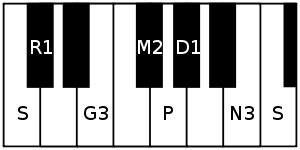
Abb.: Tonmaterial von Kāmavardhanī
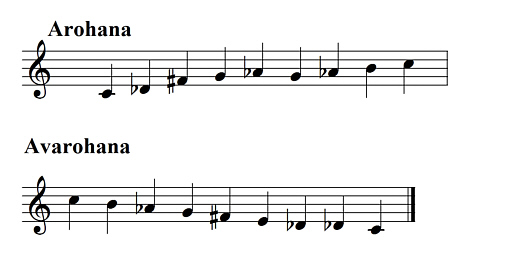
Abb.: Tonleier von Śrī
|
श्रीविश्वनाथं भजे ऽहं चतुर्दशभुवनरूपरागमालिकाभरणधरणान्तःकरणम्
śrīviśvanāthaṃ bhaje 'ham |
Ich liebe den
herrlichen Schutzherrn des Alls; das innere Organ, das trägt und behält den Kranz der Rāgas, der die Gestalt der 14 Welten hat;
|
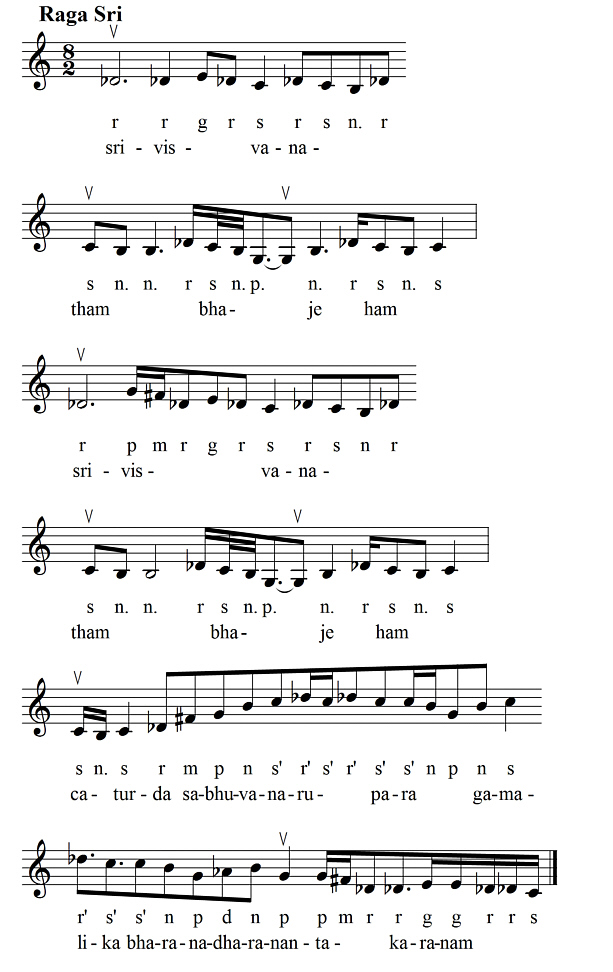
Abb.: Caturdaśa
Rāgamālikā, Pallavi, Rāga Śrī
2. Rāga Ārabhi: janya-auḍava-saṃpūrṇa-upāṅga-krama zu Meḷa 29: Dhīraśaṅkarābharaṇa
|
श्रितजनसंसारभीत्यपहं आध्यात्मिकादितापत्रयमनोभीत्यपहम्
śritajanasaṃsārabhītyāpahaṃ |
Der für die Leute, die
zu ihm Zuflucht genommen haben, die Gefahren des Laufs durch die
Wiedergeburten abwehrt; Der die drei mentalen Gefahren abwehrt, nämlich die für das innerste Ich und die anderen beiden; |
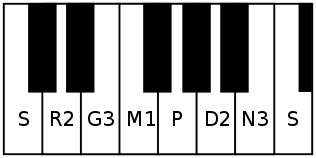
Abb.: Tonmaterial von Dhīraśaṅkarābharaṇa

Abb.: Tonleiter von Ārabhi
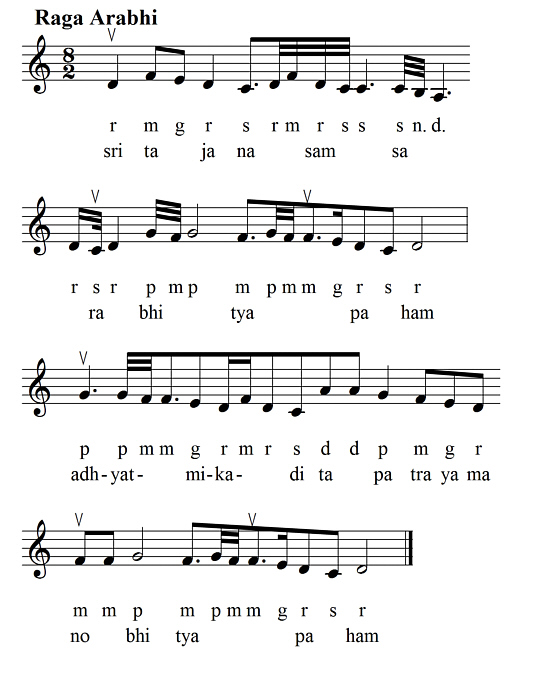
Abb.: Caturdaśa Rāgamālikā, Pallavi, Rāga Ārabhi
Es folgeni:
3. Rāga Gaurī: 2 āvartana (tāla-Einheiten). Gaurī = janya-auḍava-saṃpūrṇa-upāṅga-krama zu Mela 15: Māyāmālavagauḷa
4. Rāga Nāṭa: 2 āvartana. Nāṭa = janya-auḍava-saṃpūrṇa-upāṅga-vakra zu Meḷa 29: Dhīraśaṅkarābharaṇa
5. Rāga Gauḷa: 2 āvartana. Gauḷa = janya-upāṅga-vakra zu Meḷa 15: Māyāmālavagauḷa
6. Rāga Mohana: 2 āvartana. Mohana = janya-auḍava-auḍava-upāṅga-krama zu Meḷa 28: Harikāmbhojī
6a. Rāga Mohana: 1 āvartana
5a. Rāga Gauḷa: 1 āvartana
4a. Rāga Nāṭa: 1 āvartana
3a. Rāga Gaurī: 1 āvartana
2a. Rāga Ārabhi: 1 āvartana
1a. Rāga Śrī: 1 āvartana
7. Rāga Śyāma: 2 āvartana. Śyāma = janya-auḍava-ṣādava-upāṅga-kram zu Meḷa 28: Harikāmbhojī
8. Rāga Lalita: 2 āvartana. Lalita = janya-ṣāḍava-ṣāḍava-upāṅga-kram zu Meḷa 15: Māyāmālavagauḷa bzw. Meḷa 17: Sūryakānta
9. Rāga Bhairava: 2 āvartana. Bhairava = janya-saṃpūrṇa-ṣāḍava-upāṅga-kram zu Meḷa 17: Sūryakānta
10. Rāga Sārāṅga: 2 āvartana. Sārāṅga = janya zu Meḷa 65: Mecakalyāṇī bzw. Meḷa 64: Vācaspati
11. Rāga Śaṅkarābharaṇa: 2 āvartana. = Meḷa 29: Dhīraśaṅkarābharaṇa
12. Rāga Kāmbhoji: 2 āvartana. = Meḷa 28: Harikāmbhojī
13. Rāga Devakriyā: 2 āvartana. Devakriyā = janyaṣādava-saṃpūrṇa-upāṅga-vakra zu Meḷa 20: Naṭhabhairavī / Narabhairavī
14. Rāga Bhūpāla: 2 āvartana. Bhūpala = janya-auḍava-auḍava-upāṅga-kram zu Meḷa 8: Hanumattoḍī bzw. Meḷa 15: Māyāmālavagauḷa
14a. Rāga Bhūpāla: 1 āvartana
13a. Rāga Devakriyā: 1 āvartana
12a. Rāga Kāmbhoji: 1 āvartana
11a. Rāga Śaṅkarābharaṇa: 1 āvartana
10a. Rāga Sārāṅga: 1 āvartana
9a. Rāga Bhairava: 1 āvartana
8a. Rāga Lalita: 1 āvartana
7a. Rāga Śyāma: 1 āvartana
6b. Rāga Mohana: 1 āvartana
5b. Rāga Gauḷa: 1 āvartana
4b. Rāga Nāṭa: 1 āvartana
3b. Rāga Gaurī: 1 āvartana
2b. Rāga Ārabhi: 1 āvartana
1b. Rāga Śrī: 1 āvartana
1b. Rāga Śrī (letztes āvartana):
|
सरससदयहृदयनिलयमनिषम् sarasasadayahṛdayanilayamaniṣam |
Den, dem Weisheit mit Liebe und Sanftmut im Herzen wohnt. |

Abb.: Caturdaśa Rāgamālikā, Pallavi, Rāga Śrī
Ein volles, gelehrtes Konzertprogramm, gedacht für Conaisseure (rasika), die alle Feinheiten erkennen und genießen können. Die Regeln für die Improvisation von ālāpana, tānam und Pallavi systematisierte Paccimiriyam Āḍiyappayya (geboren 1730), ein Hofmusiker in Tañjāvūr.
Beispiele für Rāgam-Tānam-Pallavi auf Spotify:
Album, gesungen von M.L. Vasanthakumari, auf Spotify:
URI: spotify:album:2mxbLV38mnR3fPswoZeUFD
URL: https://open.spotify.com/album/2mxbLV38mnR3fPswoZeUFDAlbum von T.N. Krishnan ; Doreswamy Iyengar, K.V. Narayanaswamy ; Aruna Sairam, auf Spotify:
URI: spotify:album:3NypWcPwkXAGvrdjdAD5rL
URL: https://open.spotify.com/album/3NypWcPwkXAGvrdjdAD5rLAlbum, gesungen von Sheergazhi S. Govindarajan, auf Spotify:
URI: spotify:album:3sdeN9HklvpOzCTweFSIra
URL: https://open.spotify.com/album/3sdeN9HklvpOzCTweFSIraAlbum 2, gesungen von Sheergazhi S. Govindarajan, auf Spotify:
URI: spotify:album:1PlhueXw4lgVM2Z4ff72qo
URL: https://open.spotify.com/album/1PlhueXw4lgVM2Z4ff72qo
Virtuoses Schlagzeugsolo.
Wurde von Pudukōṭṭai Mānpūndia Pillai (19. Jhdt.) auf sein heutiges Niveau gebracht.
Maṅgala ist ein Glück wünschender und bringender Gesang. Jedes Konzert und jede Tanzaufführung sollte mit einem Maṅgala enden.
Einige beliebte Maṅgala sind:
| Name des Maṅgala | Rāga | Dichterkomponist | Auf Spotify |
|---|---|---|---|
| Nī nāma rūpamulaku | Saurāṣṭra | Tyāgarāja (త్యాగరాజ, தியாகராஜா) (1767 - 1847) | gesungen von O.S. Thyagarajan: URI: spotify:track:50JGuxV5AqHg366drhpqvu URL: https://open.spotify.com/track/50JGuxV5AqHg366drhpqvu |
| Makulamunakiha | Suraṭi | Tyāgarāja | |
| Jayamaṅgalam | Ghaṇṭā | Tyāgarāja | gesungen von Geetha Raja: URI: spotify:track:6H53juicGuHC3CN7S51Gco URL: https://open.spotify.com/track/6H53juicGuHC3CN7S51Gco |
| Jayamaṅgalam | Mohana | Tyāgarāja | |
| Jayaki nayaka niku | Dhanyāsi | Tyāgarāja | |
| Bhavamāna | Saurāṣṭram | Tyāgarāja | gesungen von Trivandrum R.S. Mani: URI: spotify:track:4oGPfBvt5KCUPuZd4uPAyP URL: https://open.spotify.com/track/4oGPfBvt5KCUPuZd4uPAyP |
| Jayamaṅgala | Dhanyāsi | Purandara Dāsa (ಪುರಂದರ ದಾಸ) (1484 - 1564) | |
| Māpāli dēvuniki | Panturavāḷi | Shahji Maharaja (1684 A.D. - 1710 A.D.) | |
| Bhujaga sāyinō | Yadukulakāmbhoji | Svāti Tirunāḷ Mahārāja (ശ്രീ സ്വാതി
തിരുനാള് രാമ വര്മ്മ) (1813 - 1846) |
von Khanda Triputa u.a.: URI: spotify:track:4sGvgrEpCfAuOVb29nZNJ2 URL: https://open.spotify.com/track/4sGvgrEpCfAuOVb29nZNJ2 |
| Śrī Rāmacandranukku | Suraṭi | Arunācalakkavirayar (1711/12 - 1788) | |
| Maṅgalam Śrī Rāmunaku | Vasanta | Mysore Sadāśiva Rao (19. Jhdt.) | |
| Srimat kakarla vamsabdi | Madhyamāvati | Wālājapet Veṅkaṭarāmaṇa Bhāgavatar (1781 - 1874) |
| "Songs of
salutation or hail, called Mangala, are sung at the conclusion of
all performances. Melodies of this kind are usually in either the
rāgas Surati or Saurāshtra. The following is one of the most common
Mangalas. The chief peculiarity in songs of this kind is evident
here—the beats of the tāla falling upon tied notes at the
commencement of a bar.
Day, C. R. (Charles Russell) <1860-1900>: The music and musical instruments of southern India and the Deccan. -- London & New York : Novello, 1891. -- xvi, 173 S. : Ill. ; 25cm. -- S. 85. |
Zu Musikalische Formen 4. Tanzmusik